As Climate Change Redraws Sundarbans, Its Women Preserve A Critical Cultural Link
A theatre troupe led by women is holding on to the folk and ritual traditions linked to the Bonbibi cult particular to this fragile delta region
- Rituparna Palit
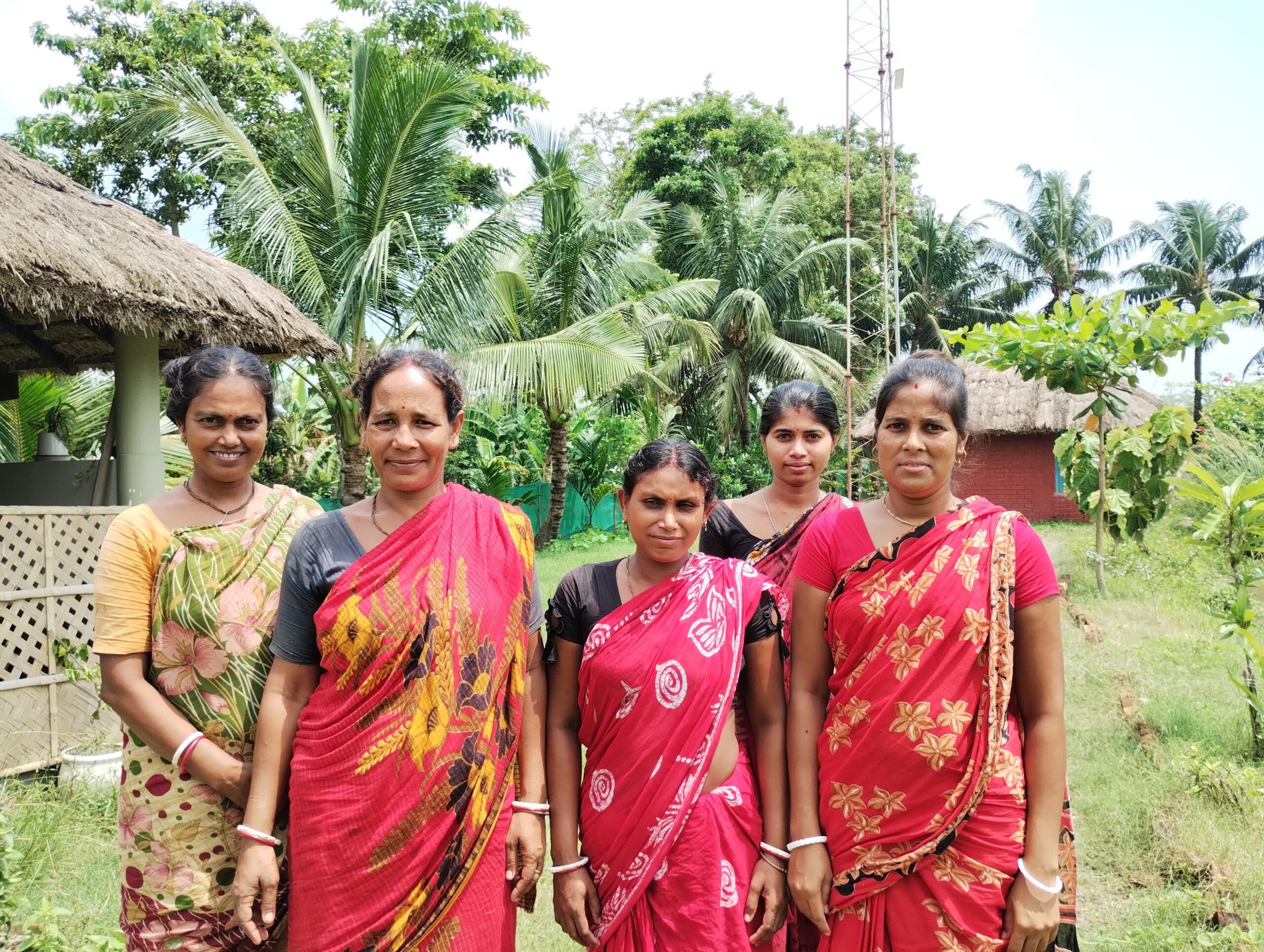
Chhobi Mahal, 45, likes to visit the Bonbibi temple in her village, Raspur, that sits facing the Bay of Bengal at Sagar Island, every day. “Or jonne bado maya hoye geche, or kache roj ek baar na asle bhalo lagena (I have grown so fond of her, I don’t feel happy if I don’t come to her at least once a day),” she says as she opens the door to the temple.
Bonbibi, draped in a red sari sitting atop a tiger, is a syncretic forest guardian worshipped across the Sundarbans. In Raspur, for instance, she is worshipped as Bonodebi with Hindu rituals. In Maipith and Tridibnagar, she is Bonbibi worshipped by the Muslims. Beside her stands Dukhe, the boy she and her brother Shah Jangali save from the tiger-god Dakshin Rai.
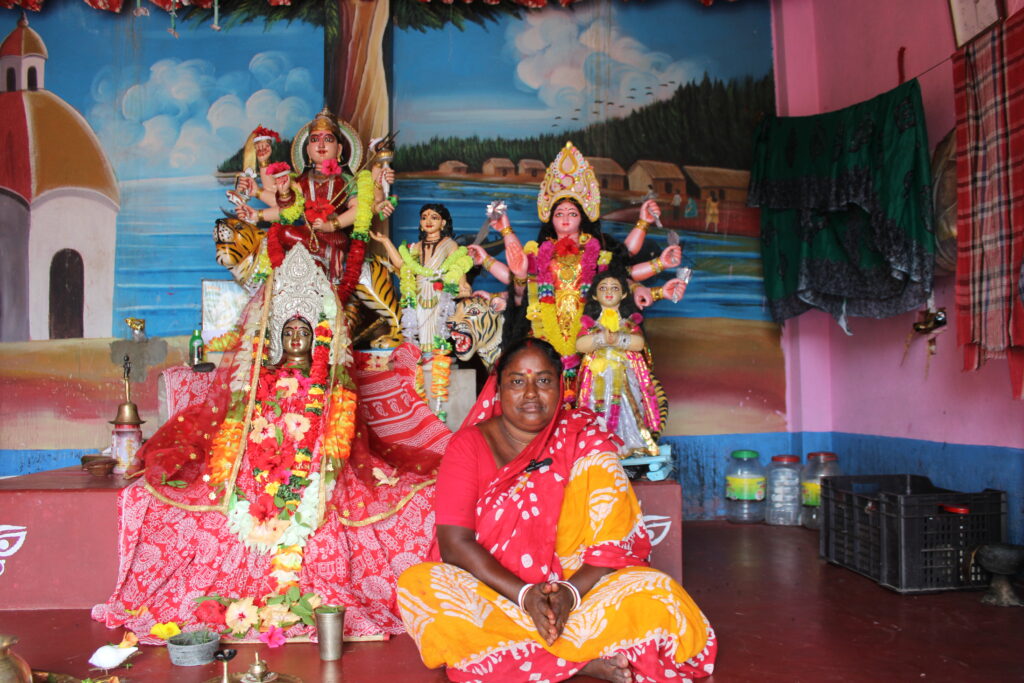
But the Raspur temple is perilously close to being swallowed by rising tides. Five decades ago it was a revered rock which then became a cement structure. Today the temple stands just 50 metres from the shore at low tide. Rising sea levels caused by climate change and soil erosion have led the waves almost to its rear wall.
Pointing to the precarious mud embankments the administration recently raised behind the temple, Chhobi says: “These vanish as the tides grow stronger. Unless there’s a permanent solution, we won’t be able to save Maa (mother). Who will the village worship then? Above all, who will protect us?”
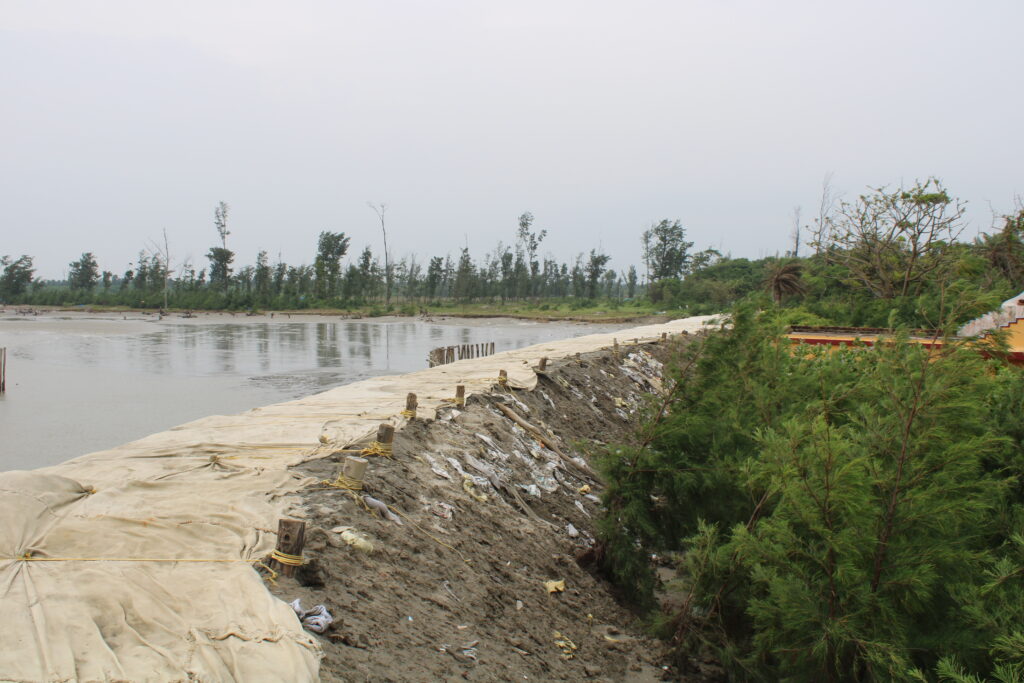
The Sagar Island sits where the Hooghly joins the Bay of Bengal, around 100 km south of Kolkata. Here, as elsewhere in the Sundarbans, especially in village shrines dedicated to Bonbibi, women often take the role of sebika (servitor). Elected by a local committee, they clean the shrines, prepare offerings, sing ritual songs, and maintain the sacred space every day.
Raspur falls under the Dhablat gram panchayat, one of Sagar Island’s fastest-eroding coastal settlements, as recorded by Jadavpur University’s School of Oceanographic Studies and the district administration. Satellite images show entire stretches of land with houses, schools, farms lost to the sea in the last two decades.
An INCOIS interim report published this year projects that extreme sea levels along Indian coasts, including islands, could rise by 0.53–0.90 m above present-day levels. The study highlights coastal vulnerability hotspots, with increased inundation risk and greater stress on low-lying regions including mangrove-fringed deltas like the Sundarbans.
Moreover, wave heights, plentiful rivers and more rivulets on the east coast makes it more vulnerable to higher erosion and inundation than the west coast.
“The original coast of Dhablat has vanished. Every cyclone only fuels the erosion further. Cyclone Aila caused massive devastation (in 2009), submerging stretches of land here,” says Chhobi’s husband Sagar Mahal, a fisher.
‘Wrong Winds’
In the Mahals’ two-room home, a poster of last year’s Bonodebi pujo (worship) dominates one wall, while machine parts await repair by their son. Sagar says dwindling fish catches—worsened by “ulto hawa” (erratic winds)—leave his income insufficient.
“Ulto hawa” is how fishers here interpret the impact of climate change – strong winds with rains arriving late and the sea turning unpredictable. The northern Bay of Bengal is warming faster than the global average. Depletion in fish catch, a widely reported concern across the Sundarbans, is forcing fishers to enter deep into the forests for crab collection, risking encounters with tigers, leopards and crocodiles, we found.
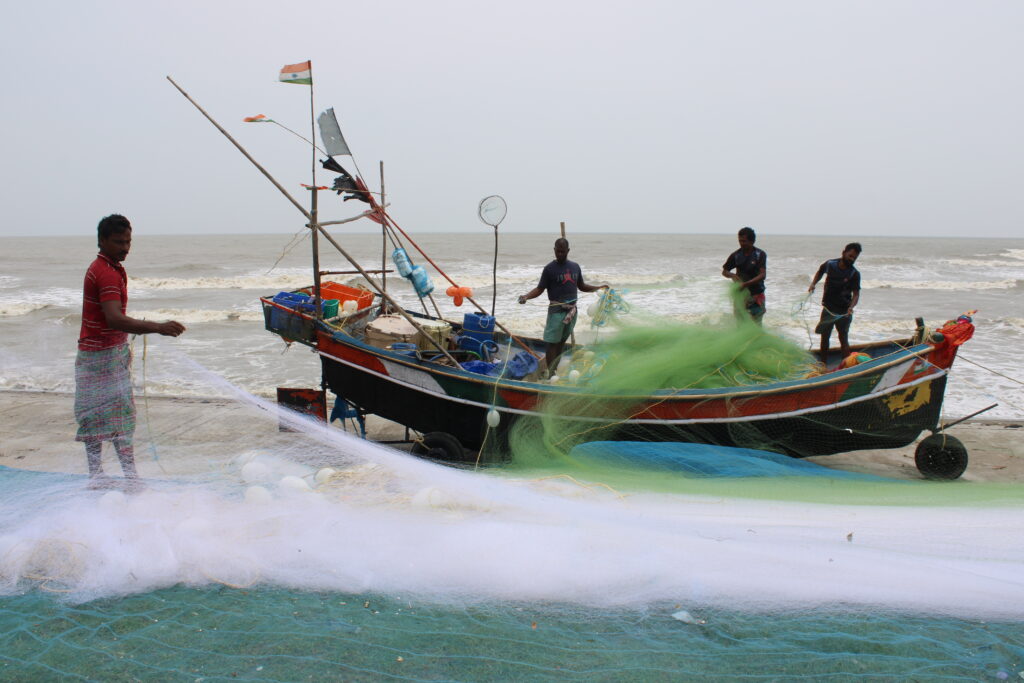
Sagar notes that the intrusion of saline waters into farmlands is forcing the men to migrate to cities for menial jobs, even as far as Kerala and Maharashtra, leaving their families behind.
The Sundarban women left behind care not just for their families but also the sociocultural fabric of the delta. Over time, this quiet continuity has positioned them as cultural custodians, leading Bonbibi rituals, preserving ecological knowledge, and passing down language and lore.
“The deity’s worship doesn’t require a Brahmin priest and is often led by women. This practice transcends caste, religion, and gender boundaries, uniting all against our one and only enemy—growing climate change,” says Mukut Biswas, founder and managing trustee of Prameya Foundation, a non-profit working in forest conservation.
Reviving Palagaan
A few islands away, in Anpur near Gosaba, theatre artist Anuja Adhikary Mondal, 41, is trying to keep Bonbibi’s story alive through her all-women troupe, Maa Suhasini Natya Sanstha. The group’s signature performance, the Bonbibir Palagaan (devotional folk music) is a musical retelling of the Johuranama—an oral tradition blending song, dance, and storytelling that once echoed through village courtyards.
Anuja’s all-women troupe, formed in 2009 after Cyclone Aila forced many men to migrate, has kept the tradition alive at state events and festivals. Palagaan performances do not earn the troupe anything but they remain passionate about its relevance in their lives.“People no longer sit through four-hour palagaans. They prefer short, flashy acts,” Anuja says.
“After Cyclone Aila wiped out our belongings, I had to find a way to feed my family,” she says. With her ailing husband unable to work and two children to support—including a blind daughter—she drew on her long experience of performing folk arts at pujas and funerals to form a women’s theatre group with 14 others.
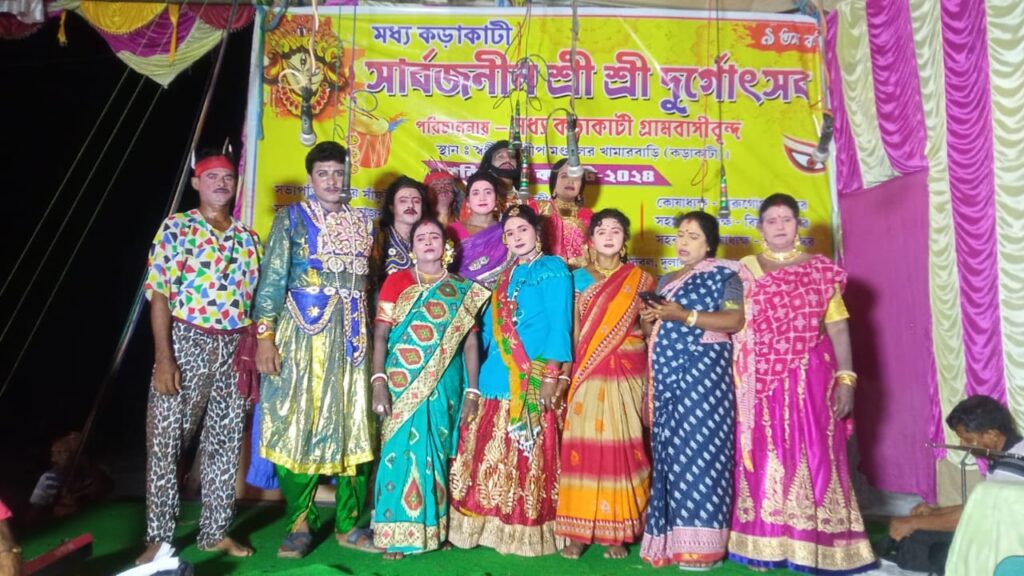
However, the tourism boom in Gosaba and other islands has increased the demand for more peppy folk dances like the jhumur. “Despite 4,000 tourists visiting Gosaba on peak days this monsoon, none called Palagaan troupes—only Jhumur dancers,” says tour operator Puranjan.
Cultural performances in the area are being increasingly tailored for the tourist palate on occasions like the ilish utsab (hilsa festival when the season for the much-loved fish peaks) which draws huge crowds.
Despite her popularity, Anuja’s troupe didn’t get any Bonbibi Palagaan requests this monsoon.
Need Over Greed
The deity’s worship rituals are guided by the book Bonbibi Johuranama, written by Abdur Rahim in the late 19th century and adapted from the epic poem Ray-Mangal (1686) by Krishnaram Das, says Annu Jalais mentions in Forest of Tigers: People, Politics and Environment in the Sundarbans.
“The Johuranama not only advocates the deity’s worship for protection, it also proscribes practices harmful to the forest, forbidding over-extraction, hunting, or disturbing wildlife. So, a principle of mutual respect emerges,” says Amrita Sen, assistant professor of sociology at the Indian Institute of Technology Kharagpur.
“Forest-goers follow strict codes—no spitting, smoking, or talking loudly, and rituals honouring ancestors before entry,” Sen notes. “At home too, restraint is observed: wives of forest-goers refrain from cooking during the day, underscoring that the forest is entered out of need, not greed.”
Unlike the Raspur community that worships Bonodebi mostly for protection from natural calamities and overall well-being, people in other parts of Sundarban turn to the deity for safe return from honey and crab collection trips in tiger-inhabited forests.
Thousands gather during the annual Bonbibi festival on the last Tuesday of the Bengali month Baisakh (April-May) at Maipeeth’s Bonbibi temple in Kultali, among the Sundarbans’ most revered shrines. “Hindus and Muslims alike participate, reinforcing the deity’s role as a unifying figure,” says Akhil Das, secretary of the temple committee.
The Kultali block and Maipeeth coastal police station jointly support the Baisakhi Bonbibi festival at Maipeeth in terms of logistics, security, sanitation, and disaster preparedness, says Suchandan Baidya, the block development officer of Kultali.
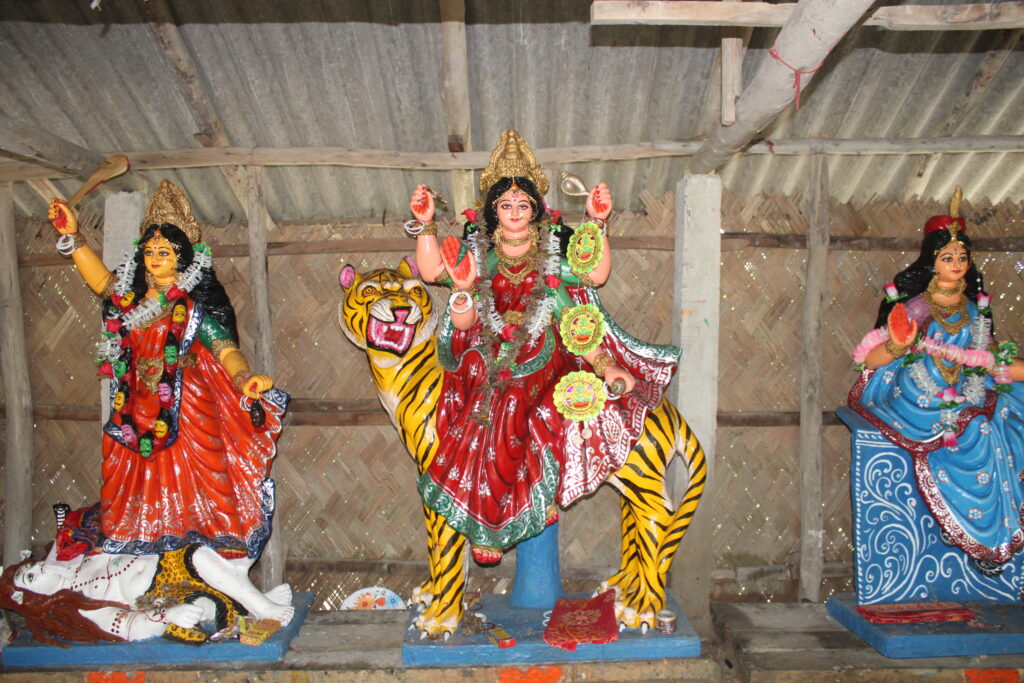
The temple is located on an uninhabited forested island where tiger sightings are frequent. On the opposite riverbank is Nagenabad, a village which is home to many ‘baagh bidhobas’ or ‘tiger widows’, women who have lost their husbands to tiger attacks. “Despite the frequent tiger attacks, our faith in Bonbibi remains unshaken,” says Das.
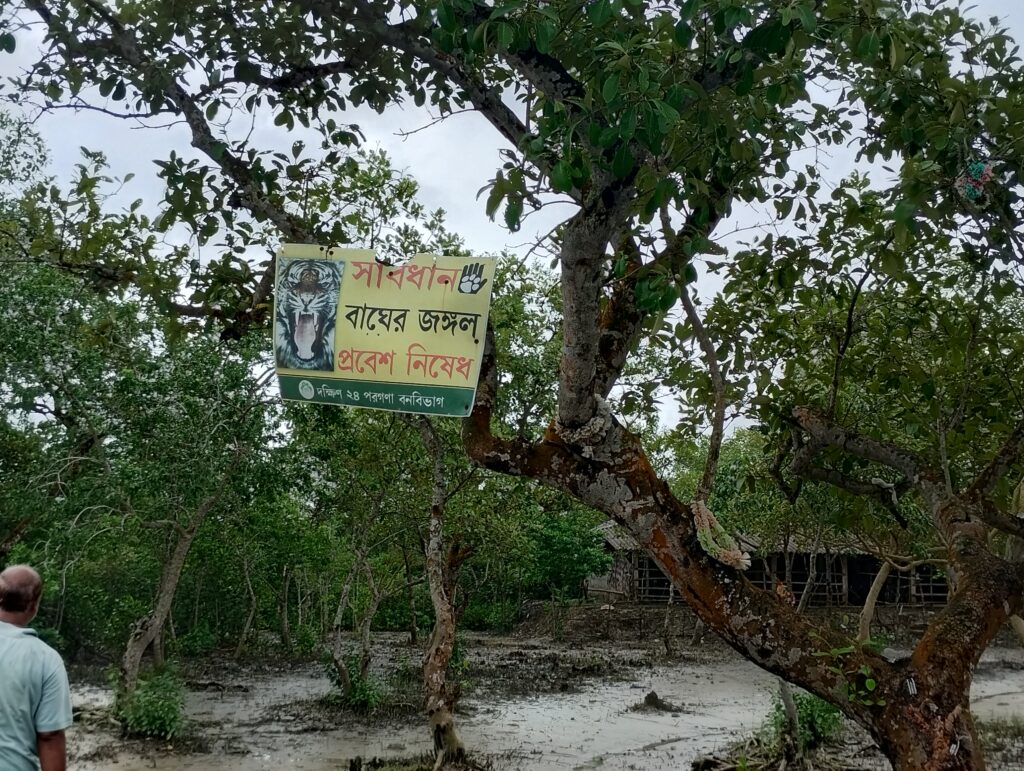
The Missing Music
Yet a defining element of the festival – the Bonbibi Palagaan – is now missing in Maitpeeth’s yearly celebrations.
“We hosted palagaans for about 10-15 years. The old performers have either migrated for better work opportunities or are no more. The youth neither learn the art nor sit through four-hour performances,” Das says.
Growing climate-driven migration has weakened some communities’ ties with Bonbibi as they shift to alternate livelihoods. The same climate vulnerabilities have deepened others’ reliance on the deity.
“Some argue Bonbibi’s significance is declining, but that’s a simplistic view. In places like Gosaba and Basanti, which are two vulnerable blocks in South 24 Parganas district with some of the highest numbers of forest-goers, people still strongly identify with her,” says Sen of IIT Kharagpur, the author of A Political Ecology of Forest Conservation in India. “People are compelled to leave ancestral lands, not by choice but by necessity, as villages submerge. But their religious identity remains tied to forest survival, and therefore Bonbibi too.” .
The Muslim elements of palagaan – the characters, iconography and the usage of Islamic terms – have all been preserved.
Government Support
This April, Anuja was awarded the Sudhi Pradhan Puraskar by the West Bengal government’s Folk and Tribal Cultural Centre (FTCC) for her contribution to the art form. She received a memento and Rs 50,000.Members of the Maa Suhasini Natya Sanstha receive Rs 1,000 monthly as retainers from the FTCC’s Lok Prasar Prakalpa (LPP) programme.
According to the Kultali BDO, the Lokprasar scheme also issues identity cards and gives performance fees of Rs 1,000 to the registered artists (200,000 as per official records), apart from pension for elderly ones.
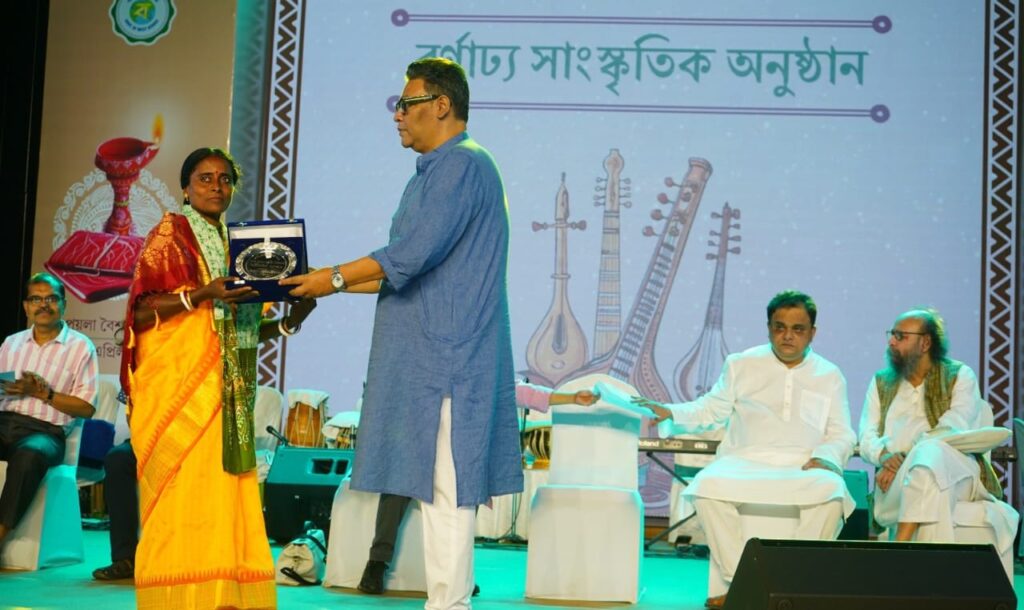
Anuja and her team are among the 50,000 folk artistes supported by a 2013 project of the state government launched in partnership with UNESCO; 374 Bonbibi Pala artistes in South 24 Parganas (252) and North 24 Parganas (122) districts are being covered under the second phase of the initiative through capacity building and sponsored events.
“We also get Rs 1,000 each from our performances at state functions,” Anuja notes. Ramayan Pala, Sagar Bhasha, Beder Meye Daalia, and Rupankanya are among the other folk theatre forms that her troupe performs.
Bonbibi is not the only deity embodying ecological faith in West Bengal’s mangroves. Villagers also turn to Manasa for protection from snakebites, Sitala to protect from smallpox and paediatric ailments, and Ganga to protect from floods and for purification of sins.
Safeguarding the traditions
Like Anuja, other women’s groups too have stepped forward to save the Bonbibi cult despite odds. At the edge of the Tridibnagar forest fringe on Jharkhali island, women come together every year to rebuild a Bonbibi shrine after heavy rainfall and storms.
Ratna Mistry, a young woman resident of the village, describes this team effort as “ei maati ta ke dhore rakhar ek cheshta (an effort to hold on to this land)”.
The shrine was a temporary bamboo-and-cloth structure erected annually during the puja season. A semi-permanent structure was first created around 2022, mainly from local contributions. “We have been considering making it more permanent, but the sentiment of keeping it as a living, community-renewed tradition is still strong,” says Mukut of the NGO Prameya that leads the effort.
Ratna says this monsoon, her family incurred huge losses to several crops such as pumpkin, bottle gourd, ridge gourd and pointed gourd. “The heavy rains not only damaged new shoots, but also full-grown plants,” she adds.
To save the shrines or idols, communities often re-site them to safer grounds farther from the forest edge. This has disrupted the age- old link between ritual and resource access, notes Baidya the BDO.
Passing On A Tradition
In Patharpratima block’s Kuemuri village, Soma—a teenager—performs the daily puja rituals at a Bonbibi temple built on the forest department office campus.
“I like serving Maa Bonbibi. I have been performing these tasks daily since I was a kid,” says the Class 11 student studying arts at a nearby school. Her father works in the forest department office.
Forest department employee Tapan Kumar Das says, “Most forest (department) offices in Sundarbans have a Bonbibi temple on campus. This also brings us closer to the local communities. We have a grand four-day event during the annual pujo, which kicks off with a Bonbibi Palagaan. I’m a rational man, yet in the forest I pray to her—and despite many tiger rescues, none of us has ever been hurt. As we step into the forest, we apply tilak with the soil in the name of Maa Bonbibi.”
[This story was produced with support from Internews’ Earth Journalism Network.]
We believe everyone deserves equal access to accurate news. Support from our readers enables us to keep our journalism open and free for everyone, all over the world.

